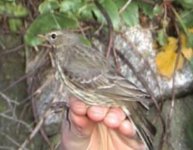Binocularface
You've all got one...............!
I am not totally convinced that the images posted by Steve are not Water Pipit (I am not saying they are!). There are a few features on the bird which in my opinion (and limited experience) are pro-Water Pipit.
1) The streaking on the breast and flanks seems to be more defined and less 'smudgy' than I would expect in Rock Pipit
2) The wingbars are very pale (would not expect them to appear so striking in Rock Pipit).
3) The throat is very pale and open in appearence
4) The tertial edges appear very pale
I would suggest (but not state!) the bird is a winter plumaged Water Pipit!
Well that is my two-penith- I now stand to be corrected!
Regards
Tristan
1) The streaking on the breast and flanks seems to be more defined and less 'smudgy' than I would expect in Rock Pipit
2) The wingbars are very pale (would not expect them to appear so striking in Rock Pipit).
3) The throat is very pale and open in appearence
4) The tertial edges appear very pale
I would suggest (but not state!) the bird is a winter plumaged Water Pipit!
Well that is my two-penith- I now stand to be corrected!
Regards
Tristan







